|
|
|
|
|
|
Coat Colour in Bull Terriers
There are a limited number of coat colours in Bull Terriers. All Bull Terriers fall into one of two groups:

There is the iconic White Bull Terrier which is either all white or may have small patches of colour, and the Coloured Bull Terrier which, while it may have some white markings, is predominantly coloured - either Brindle, Red, Black & Tan or Black Brindle.
In order to understand coat colour in Bull Terriers it is only necessary to know that there are three sets of genes causing these colour varieties. In a simplified way, they are:
1. Base Coat Colour gene (known as the Agouti- or A-Locus Series) This gene causes two options:
Red Base Coat –

This is a plain red base coat (seen in a Red dog or found under the brindle pattern of a Brindle dog). The plain red base coat can vary from light tan through to a deep red brown.
Black on Red Base Coat –

This is a black overcoat on the red base coat (seen in a Black & Tan/Tricolour dog or under the brindle pattern of a Black Brindle dog). The black overcoat on the red base coat will be referred to here as Black on Red and is essentially a black covering on the red base coat. This black covering does not fully extend over the red and the red colour can be seen on the face forming eyebrows and cheek patches, on the chest, lower legs and under the tail. The extent of red showing around the edges of the black varies in individual dogs.
2. Brindle Patterning gene (known as the K-Locus Series) This gene causes two options:
No Brindle Pattern –

This is seen in Red dogs and Black & Tan/Tricolour dogs.
Brindle Pattern –
Brindle is a pattern of black stripes on the background colour of the base coat.

The brindle pattern on the Red base coat shows as a Brindle dog and the brindle pattern on a Black on Red base coat shows as a Black Brindle dog. Variation in the shade of colour of the base coat and the width of the black stripes can result in unique brindle patterns.
3. White Masking gene (known as the S-Locus Series)
This gene controls the amount of white pattern masking the colour of the dog.
A complete white mask results in a White Bull Terrier.
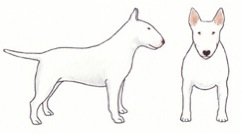
It is important to realise that a White Bull Terrier has got colour (a Red or Black on Red base coat and a Brindle pattern or not) like any Coloured Bull Terrier. The white mask is simply covering it and preventing it from being visible.
The white mask pattern may not cover the whole dog. It may cover part of the face, throat, neck and chest, much of the under-body, the lower legs and the tip of the tail. This results in a Coloured & White Bull Terrier (white should only cross the back of the dog at the neck).
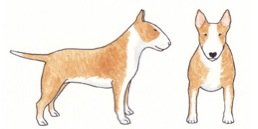
A Bull Terrier with no white markings or very limited white patches without any extension over the back at all is a Solid Coloured Bull Terrier.
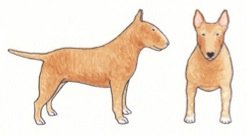
In Bull Terriers, a less important fourth gene (MC1R gene) is responsible for the dark facial mask known as smut marking. Up until 2007, it was believed that only Red Bull Terriers could have smut markings and that Brindle, Black Brindle and Black & Tan/Tricolour Bull Terriers did not have this at all. We now know that all Coloured Bull Terriers can have smut markings. It is only is Red Bull Terriers that the mask is easily visible. In the other Coloured and White Bull Terriers the mask is either camouflaged by dark brindle patterning, hidden by the Black on Red base coat or covered by the white mask.
The different genetic combinations produce the following coat colour options in Bull Terriers:
1) White –
These appear all white but they may have patches of colour, most likely on the head near the ears and eyes. They are, however, not really white as all White Bull Terriers carry colour and pass on colour to their offspring even though that colour may not be visible. The White expression is a ‘mask’ hiding the true genetic colour of the dog. A careful look at the hairs around the ears of an all-White Bull Terrier can help figure out what colour it is carrying.
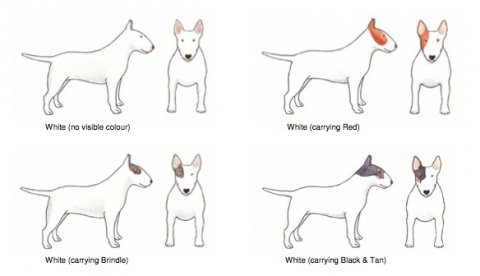
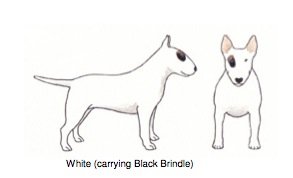
2) Red –
This colour ranges from light tan through to deep, dark, rich, rust red. The colour “fawn” is a very pale version of this. Fawn colour is caused by the same gene as Red colour but the difference in expression is due to the rufous polygenes which, when inactive, result in a so-called ‘cold’ colour. There are different varieties –
Red Solid – red with hardly any white markings – it might have a small white blaze on the nose, patch on the chest and white on the toes
Red & White – red with strong white markings on the nose, collar, chest, underbelly, lower legs and feet and tail tip.
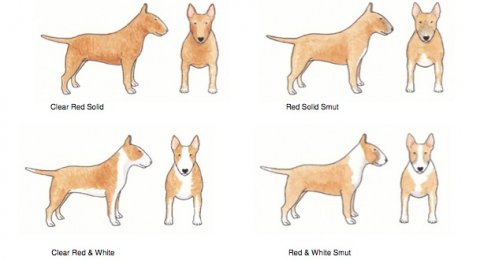
3) Brindle –
This is a pattern of fine black lines superimposed on a variable red/fawn base colour producing a wide range of colours – gold brindle, silver brindle, red brindle and from light to dark brindle. There are two varieties –
Brindle Solid – brindle with hardly any white markings – it might have a small white blaze on the nose, patch on the chest and white on the toes
Brindle & White – brindle with strong white markings on the nose, collar, chest, underbelly, lower legs and feet and tail tip.

4) Black and Tan/Tricolour –
This pattern is black with tan (red) markings on the eyebrows, cheeks, chest, lower legs and bottom. If minimal white is present, it is called a Black & Tan Solid (also known as Tricolour Solid) but if there is black and tan colouring with white markings on the face, collar, chest, underbelly, feet and tail, then it is called Black & Tan & White or, more commonly, is it simply called Tricolour (it is not a Solid).

5) Black Brindle –
This pattern is black with brindled markings on the eyebrows, cheeks, chest, lower legs and bottom. The brindle colour can be very variable. If minimal white is present, it is called a Black Brindle Solid but if there is black and brindle colouring with white markings on the face, collar, chest, underbelly, feet and tail, then it is called Black Brindle & White.

General Rules of Colour Expression in Bull Terriers:
-
There are only three different genes causing colour variation in Bull Terriers.
-
These genes affect:
o the extent of white;
o the basecoat colour and
o the brindling pattern.
-
This results in nine colour variations in Bull Terriers:
o White
o Brindle Solid
o Brindle & White
o Red Solid
o Red & White
o Black & TanSolid (also known as TricolourSolid)
oTricolour (also known as Black&Tan & White)
o BlackBrindleSolid
o BlackBrindle&White
What coat colours are producing in different matings? Let us look at each gene separately first.
Inheritance of the White Mask
Any Bull Terrier will be one of three genetic options as far as the White Mask is concerned:
-
White – that is the body is all white with or without coloured head markings
-
Coloured & White – predominantly coloured (not white) with strong white collar crossing the back, white chest, under-body, muzzle, blaze and feet
-
Solid Coloured – all Coloured with or without limited white markings on the muzzle, chest and/or feet

|
|
|

|
|
|
|
50% White
50% Coloured & White
|
|
|
|
50% White
50% Coloured & White
|
25% White
50% Coloured & White 25% Solid Coloured
|
50% Coloured & White 50% Solid Coloured
|
|

|
|
50% Coloured & White 50% Solid Coloured
|
 |
Inheritance of the Base Coat Colour
Any Bull Terrier will be one of three genetic options as far as the Base Coat Colour is concerned:
-
True Red – as in the Red Bull Terrier or Brindle Bull Terrier that has no parents nor grandparents that are Black & Tan/Tricolour or Black Brindle
-
Red carrying Black on Red – this Bull Terrier looks Red or Brindle but carries the gene to produce Black on Red colour as well as Red. This dog will have either a parent or a grandparent which is Black & Tan/Tricolour or Black Brindle
-
Black on Red – as in the Black & Tan/Tricolour and Black Brindle Bull Terriers

|
|
Red carrying Black on Red
|

|
|
|
|
|
|
|
Red carrying Black on Red
|
|
|
|
|

|
|
|
 |
Inheritance of the Brindle Pattern
Any Bull Terrier will be one of three genetic options as far as the Brindle Pattern is concerned:
-
True Brindle – this Bull Terrier has brindle pattern on a red base coat appearing as a Brindle dog or it has the brindle pattern on a Black on Red base coat where just the red parts are brindled as in the case of Black Brindle dog. This dog has both Brindle parents and grandparents
-
Brindle carrying No Brindle Pattern – this dog is Brindle or Black Brindle as described above but it has a non-Brindle parent or grandparent (i.e. Red or Black & Tan/Tricolour)
-
No Brindle Pattern – the dog is either Red or Black & Tan/Tricolour with no sign of any brindle pattern

|
|
Brindle carrying No Brindle Pattern
|

|
|
|
|
|
|
|
Brindle carrying No Brindle Pattern
|
|
75% Brindle
25% Not Brindled
|
50% Brindle
50% Not Brindled
|
|

|
|
50% Brindle
50% Not Brindled
|
 |
If a dog is White and the colour they are carrying is discernable, then the colour probabilities of the offspring can be predicted by using that known colour in these colour charts.
It must be highlighted that the actual proportions of the different colours presented in these tables will only be evident with very large numbers of puppies as a single litter of puppies is too small statistically to reflect this.
General Rules of Colour Inheritance in Bull Terriers:
-
Two White parents always produce all White puppies. These White puppies may have coloured marks on their heads but they will always be almost all White in colour. Two White parents cannot produce a predominantly Coloured puppy.
-
A White parent can never produce a Solid Coloured puppy – it can only produce a Coloured & White or an all White puppy.
-
A Solid Coloured parent will never produce an all White puppy. Even with a White mate, a Solid Coloured parent will produce Coloured & White puppies but never all White.
-
Two Solid Coloured parents will produce all Solid Coloured puppies.
-
A Solid Coloured parent and a White mate will produce all Coloured & White puppies.
-
A Solid Coloured parent and a Coloured & White mate can produce Solid Coloured and Coloured & White puppies (with a one in two chance for either).
-
A Coloured & White and an all White parent can produce White puppies and Coloured & White puppies (with a one in two chance for either).
-
In fact any Coloured & White parent has a one in two chance of producing Coloured & White puppies no matter what colour the mate is.
-
Two Coloured & White parents have a one in four chance of producing Solid Coloured puppies, a one in four chance of producing all White puppies and a two in four chance of producing Coloured & White puppies.
-
Brindle puppies will only result when either one of the parents is Brindle or White carrying Brindle. If a dog has a Brindle gene, they will show Brindle (either Brindle, Brindle & White, Black Brindle or Black Brindle & White) and only then can they pass Brindle on to their offspring. The only exception to this is if it is a White dog carrying that Brindle without any coloured marks to show it.
-
Two non-Brindle parents can never produce a Brindle puppy.
-
If Black & Tan Solid, Tricolour, Black Brindle Solid or Black Brindle & White dogs are bred with each other, the offspring will only be one of these four options.
By Tracey Butchart August 2009 Illustrations by Duncan Butchart
|
|
|
|
|
|
|
|